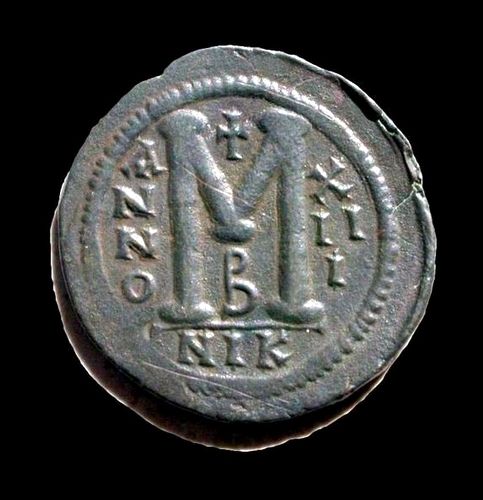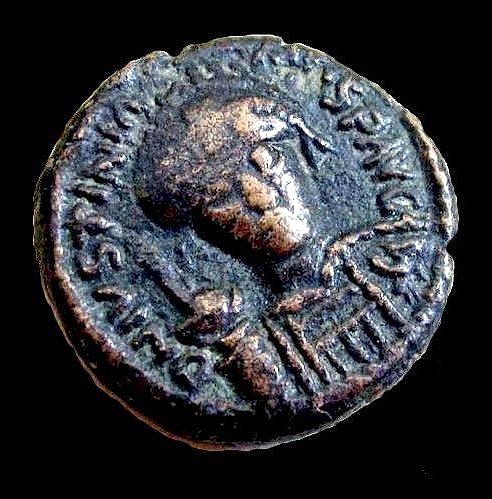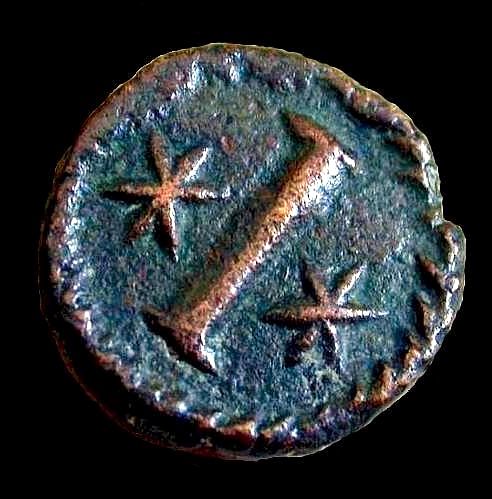

Follis, Justinian I, AD 527 - 565 |
| |
|
Flavius Petrus Sabbatius Justinianus was the adoptive son of his uncle, the emperor Justin I. Justinian ruled jointly with Justin until AD 527 when he succeeded as sole ruler. In military matters Justinian followed a policy of reconquest in North-Africa, Italy and Spain. He made a peace treaty with Persia in 532 and entrusted unrest on the homefront to his general Belisarius. Justinian was famous for his exstensive building projects and the codification of the Roman legal system. During his reign a number of natural disasters, i.e. floods, the earthquake of 542 and the onset of the bubonic plague, occurred in the empire and contributed to the depletion of the imperial treasury. Obv. Profile bust of Justinian I facing right, diademed, draped, and cuirassed. The split legend on the obverse reads D N IVSTINIANVS PP AVG. The abbreviation DN (Dominus Noster) is displayed as the conventional beginning for imperial titulature, and includes the abbreviated title of the emperor, the perpetual Augustus: P[PER]P[ETVVS] AVG[VSTVS]. During the Roman period split legends on the obverse of coins indicated that the ruler depicted was the senior Augustus. An unbroken obverse legend usually indicated a Caesar or junior Augustus, whereas the abbreviation PP (Pater Patriae - father of his country) formerly indicated a title held only by those Augusti deemed worthy of it. Rev. Denomination M between two stars, decorative cross above, symbol below M, in ex. THEU (minted at Antioch, previously Theoupolis) flanked by two crosses.The transition from Roman to Byzantine coinage during the fourth and fifth centuries is characterised by the gradual replacement of pagan imagery with Christian religious imagery. On coins of Theodosius II, for instance, a cross replaced the staff formerly carried by Victory. The christogram appeared AD 315 on a medallion of Constantine I; on some bronze coins of Siscia (320), and again in 327 on bronze coins celebrating the victory of Constantine over the pagan Licinius in 324. During Justinian's reign pagan imagery disappeared from Roman coinage in the East. |
AE follis, Justinian I, AD 527 - 565 |
 |
 |
Obv. Justinian I facing, D N IVSTINIANVS PP AVG. Rev. Denomination large M, decorative cross above, ANNO XIII (year of reign 13), D = workshop, NIK = Nicomedian mint. Justinian introduced the full facing portrait in AD 538. Here he is shown facing, with a plumed helmet, a cuirassed bust, holding a globus cruciger in his right hand, with a shield covering his left shoulder. As naturalistic representation of emperors became less important, emphasis on costume and insignia became more prominent. The simple diadem, for instance, is replaced by an elaborate helmet or crown with pendilia hanging down both sides of the emperor's face. The Christian cross is displayed in the right field. Whereas Roman emperors were usually depicted holding an orb to signify the universal power of the ruler, frontal portraits during the Byzantine period showed the emperor holding a similar globe, but surmounted by a large cross, thereby rendering the image Christian. The globus cruciger first appeared in 423 on the reverses of the coinage of Theodosius II. On the coinage of Justinian I it became the symbol of Byzantine sovereignty, replacing the customary spear of the emperor. The image of the emperor, however, remained in essence military. |
Decanummium, Justinian I, AD 527 - 565 |
 |
 |
Obv. Justinian I facing, helmeted, holding globus cruciger, D N IVSTINIANVS P AVG. Rev. Large I between two stars, mint Rome. |
| Anastasius I | Justin II | Maurice | Michael IV |
| Republican | Imperatorial | |
Imperial | Greek Imperial |